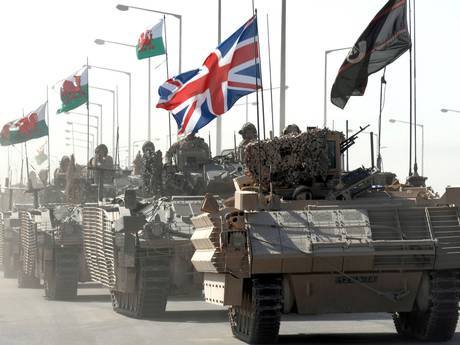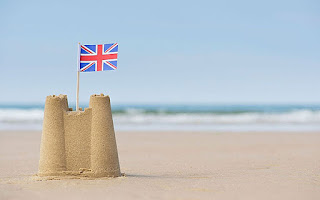The phrase East of Suez is so inextricably linked with Britain's imperial past that even the mention of it evokes images of cruisers on far flung tropical stations, colonial officials in white linen suits, and all the mystery and adventure of 'the Orient'. Almost inevitably, like all of the other trappings of empire, East of Suez was abandoned and consigned to the history books in 1968. Britain had simply become too small, backwards and poor to continue pretending that it could project force half way around the world. All it took was a government willing to accept Britain's new place in the world, as a diminished regional power, before all the Imperial pretense fell by the wayside. This is how the story usually ends, with a nation in terminal decline, a defining moment in the steady fall of an empire.
Unfortunately for the neat and ordered history of the rise and fall of empires, there is another story of Britain's involvement East of Suez, and it's not nearly as clear cut. While it is true that British troops withdrew from a range of military bases from the Gulf to the Far East, following the 1967 Sterling crisis, the UK never fully disengaged from the region. Before the 1971 date for final withdrawal Britain had already helped establish the five powers defence arrangements, a series of bilateral defence treaties with the leading commonwealth countries in the region, that guarantee the sovereignty of Malaysia and Singapore. By working closely with the new and old commonwealth partners Britain laid the foundations for a 'quiet alliance' that has kept the peace in the region for over 40 years. The security and independence of Malaysia and Singapore remain vital interests for the UK. The strait of Malacca, which borders both countries, handles around one quarter of global traded goods and keeping the waterway open and free ensures that oil, commodities and manufactured goods can flow freely between Europe and the rising Asian economies. The British permanent commitment is small and very cheap: a dock complex in Sembawang, Singapore and 'Naval Party 1022'- the few staff required to man it. Recent developments seem to suggest that post Afghanistan the UK intends to become more, rather than less, involved with the FPDA. Suggestions that for the first time in quite a while British soldiers and airmen will be exercising with their five powers partners is a sign that this 'soft alliance' is stronger and more important than ever.
While the Royal Navy's presence in South East Asia has reduced significantly since the 1968-71 withdrawal from its bases in the region the UK has maintained an impressive ability to surge maritime forces to the region when necessary. The 1983-4 Orient Express deployment saw a UK Task Group conduct a tour of the Indian Ocean and Far East. Led by the light carrier Invincible and including three frigates, a destroyer, a diesel-electric submarine and two RFA support ships the group visited a number of ports in India before heading on to Singapore and exercising with the American and South Korean navies in the South China sea. Similar large group naval deployments to the Far East were conducted in 1992 and 1997. The increased pressure on the surface fleet, due to diminishing escort numbers since the end of the Cold War and the heavy burdens imposed by the conflicts in Iraq and Afghanistan, have made these large flag-flying exercises a rare occurrence since 2001. The Task Group deployments have been replaced by single-ship tours of the region, such as Daring's 2013 visit to Australia. Despite a smaller surface fleet, the UK has continued to demonstrate an impressive ability to surge substantial naval forces into the region when necessary. This was demonstrated in the same year, when Typhoon Haiyan devastated the Philippines. Daring and the carrier Illustrious was sprinted out to South East Asia to provide disaster relief, stopping to take on supplies at Sembawang dock in Singapore. This just goes to show that the UK's ability to reach around the globe, and into East Asia, with naval forces remains substantial.
The other major military component of Britain's presence in Southeast Asia is the army's garrison in Brunei. Some 2000 troops remain permanently based in the small sultanate near the North coast of Borneo, centered on one of the Gurkha infantry battalions and its supporting forces. The forces are funded by the Sultan and base facilities have been provided to Britain on a five year rolling lease since 1962. Political and military ties between the two countries remain exceptionally strong and look set to remain so for the foreseeable future. The forces stationed in Brunei currently form the UK's Far East acclimatised reserve, in recent years they have taken part in the interventions in East Timor, Sierra Leone and Afghanistan. The British army's jungle warfare courses are also taught there, using the thick rain forests and tropical climate as the ideal location for practical training, particularly for special forces. In support of this mission the army also stations a number of Bell 212 Twin Huey helicopters in the country, as part of 7 flight Army Air Corps. These were deployed following the 2004 Tsunami which struck Indonesia, as part of the disaster relief operation in Northern Sumatra. Brunei became the sole permanent UK military base in the Far East after the handover of Hong Kong in 1997 but, unlike the former colony, its use as a jumping-off point for action in the region has been relatively uncontroversial.
| The Armilla Patrol laid the foundations for current UK presence in the Gulf |
The first step towards a post-imperial role for the UK was taken in 1980, the Iran-Iraq war threatened to spill over into the Persian Gulf, an area vital for the movement of crude oil and petroleum products at this time. To safeguard shipping during the conflict the Armilla patrol was established. This has entailed a constant minimum presence of at least one frigate, destroyer and a nuclear powered attack submarine, supported by an RFA tanker, ever since. These forces have been scaled up and down in proportion to the needs of the government, as well as the threat to UK interests at the time. During the 1990-91 Gulf War eleven RN warships and six RFA supporting vessels were assigned to Operation Granby, with the destroyers Gloucester and Cardiff playing a leading role in the destruction of the Iraqi navy. An even larger force was assembled for the 2003 invasion of Iraq. Seventeen warships, including the carrier Ark Royal and the assault ship Ocean, supported by thirteen RFAs, deployed to the Gulf. Although the two surge efforts during the wars with Iraq were atypical, constant naval presence with powerful surface and sub surface combatants, has formed the bedrock of the UK's Gulf presence since 1980. In view of this, the recent news that the UK is to establish a naval base in Bahrain shouldn't come as a great surprise. Substantial maritime forces have been deployed in the region for so long that significantly shortening their logistics train through forward basing makes sense. In terms of military value alone the move will free up a number of RFAs currently dedicated to supporting the RN's presence in the region. Forward maintenance facilities will be essential to get the most out of the current small pool of nineteen high-end surface escorts.
Due to the rise in piracy around East Africa between 2005 and 2013 the UK has contributed surface escorts and RFAs intermittently to the multinational combined task force, established in 2009, to safeguard merchant shipping in the area. Since 2010 there has been a marked decline in the seizure of vessels by pirates in the area, in part because of the efforts of international maritime forces.
The Gulf and surrounding region looks set to remain the area where the greatest military threats to Britain's economic prosperity could emerge in the future. The recent nuclear deal with the Iranian regime is a positive start, but there still remains a great divide between the Islamic republic and the West. In concert with partners in the region and around the world the UK presence will continue to act as a deterrent to any state or non-state actors that would threaten the freedom of merchant shipping in these important waterways.
| Afghanistan: projecting UK power East of Suez |
Few other countries can boast the ability to sustain such a large and capable force in high intensity combat for as long as the UK did. It must also be remembered that this force was projected into a land-locked country half way around the world, and that until 2008 the army also had significant forces deployed to southern Iraq. This ability alone demonstrates that Britain deserves to be counted amongst the world's serious military players. I'll reserve a finer analysis of the conflict and it's outcome until a later date. However, the essential take away is that the British armed forces have fought some of their hardest battles since the 1950s, in one of the longest wars fought in recent years, with large and capable forces projected East of Suez.
 |
| Royal Navy forces contribute to maritime security in the Persian Gulf |
The huge variety of defence activity that still takes place East of Suez is anything but an anachronism. The imagery of a long lost colonial past may still resonate strongly, but since 1968 Britain has transformed it's role in that area. No longer the declining colonial power but a dynamic and vibrant medium power with security needs and national interests that spread around the world, backed up by an enviable raft of defence agreements and alliances and in possession of highly capable armed forces. Just like the title of this post, Britain's 'withdrawal' from East of Suez is a misnomer. We never really left.




